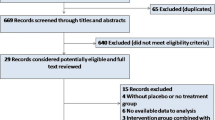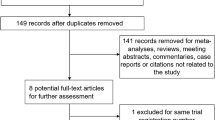Abstract
Background
Primary percutaneous coronary intervention (PPCI) is the standard reperfusion treatment in ST-segment elevation myocardial infarction (STEMI). Intracoronary thrombolysis (ICT) may reduce thrombotic burden in the infarct-related artery, which is often responsible for microvascular obstruction and no-reflow.
Methods
We conducted, according to the PRISMA statement, the largest meta-analysis to date of ICT as adjuvant therapy to PPCI. All relevant studies were identified by searching the PubMed, Scopus, Cochrane Library, and Web of Science.
Results
Thirteen randomized controlled trials (RCTs) involving a total of 1876 patients were included. Compared to the control group, STEMI ICT-treated patients had fewer major adverse cardiac events (MACE) (OR 0.65, 95% CI, 0.48–0.86, P = 0.003) and an improved 6-month left ventricular ejection fraction (MD 3.78, 95% CI, 1.53–6.02, P = 0.0010). Indices of enhanced myocardial microcirculation were better with ICT (Post-PCI corrected thrombolysis in myocardial infarction (TIMI) frame count (MD − 3.57; 95% CI, − 5.00 to − 2.14, P < 0.00001); myocardial blush grade (MBG) 2/3 (OR 1.76; 95% CI, 1.16–2.69, P = 0.008), and complete ST-segment resolution (OR 1.97; 95% CI, 1.33–2.91, P = 0.0007)). The odds for major bleeding were comparable between the 2 groups (OR 1.27; 95% CI, 0.61–2.63, P = 0.53).
Conclusions
The present meta-analysis suggests that ICT was associated with improved MACE and myocardial microcirculation in STEMI patients undergoing PPCI, without significant increase in major bleeding. However, these findings necessitate confirmation in a contemporary large RCT.










Similar content being viewed by others
Availability of Data and Material
Not applicable.
Code Availability
Not applicable.
References
Ibanez B, James S, Agewall S, et al. 2017 ESC Guidelines for the management of acute myocardial infarction in patients presenting with ST-segment elevation: the task force for the management of acute myocardial infarction in patients presenting with ST-segment elevation of the European Society of Cardiology (ESC). Eur Heart J. 2018;39:119–77.
Henriques JP, Zijlstra F, Ottervanger JP, et al. Incidence and clinical significance of distal embolization during primary angioplasty for acute myocardial infarction. Eur Heart J. 2002;23:1112–7.
Ciofani JL, Allahwala UK, Scarsini R, et al. No-reflow phenomenon in ST-segment elevation myocardial infarction: still the Achilles’ heel of the interventionalist. Future Cardiol. 2021;17:383–97.
De Maria GL, Patel N, Kassimis G, Banning AP. Spontaneous and procedural plaque embolisation in native coronary arteries: pathophysiology, diagnosis, and prevention. Scientifica (Cairo). 2013;2013:364247.
Kassimis G, Davlouros P, Patel N, et al. Adenosine as an adjunct therapy in ST elevation myocardial infarction patients: myth or truth? Cardiovasc Drugs Ther. 2015;29:481–93.
Sezer M, Oflaz H, Gören T, et al. Intracoronary streptokinase after primary percutaneous coronary intervention. N Engl J Med. 2007;356:1823–34.
Sezer M, Çimen A, Aslanger E, et al. Effect of intracoronary streptokinase administered immediately after primary percutaneous coronary intervention on long-term left ventricular infarct size, volumes, and function. J Am Coll Cardiol. 2009;54:1065–71.
McCartney PJ, Eteiba H, Maznyczka AM, et al. Effect of low-dose intracoronary alteplase during primary percutaneous coronary intervention on microvascular obstruction in patients with acute myocardial infarction: a randomized clinical trial. JAMA. 2019;321:56–68.
Gibson CM, Kumar V, Gopalakrishnan L, et al. Feasibility and safety of low-dose intra-coronary tenecteplase during primary percutaneous coronary intervention for ST-elevation myocardial infarction (ICE T-TIMI 49). Am J Cardiol. 2020;125:485–90.
Fu Y, Gu XS, Hao GZ, et al. Comparison of myocardial microcirculatory perfusion after catheter-administered intracoronary thrombolysis with anisodamine versus standard thrombus aspiration in patients with ST-elevation myocardial infarction. Catheter Cardiovasc Interv. 2019;93:839–45.
Geng W, Zhang Q, Liu J, et al. A randomized study of prourokinase during primary percutaneous coronary intervention in acute ST-segment elevation myocardial infarction. J Interv Cardiol. 2018;31:136–43.
Moher D, Liberati A, Tetzlaff J, Altman DG; PRISMA Group. Preferred reporting items for systematic reviews and metanalyses: the PRISMA statement. Ann Intern Med. 2009; 151: 264–269, W64.
Gibson CM, Cannon CP, Murphy SA, et al. Relationship of TIMI myocardial perfusion grade to mortality after administration of thrombolytic drugs. Circulation. 2000;101:125–30.
Greco C, Pelliccia F, Tanzilli G, et al. Usefulness of local delivery of thrombolytics before thrombectomy in patients with ST-segment elevation myocardial infarction undergoing primary percutaneous coronary intervention (the Delivery of Thrombolytics Before Thrombectomy in Patients With ST-Segment Elevation Myocardial Infarction Undergoing Primary Percutaneous Coronary Intervention [DISSOLUTION] Randomized Trial). Am J Cardiol. 2013;112:630–5.
Ibrahim IM, Eldamanhory AS, Abdelaziz M, Abdelaziz A. Impact of low-dose intracoronary alteplase infusion after successful primary percutaneous coronary intervention. Int J Clin Cardiol. 2019;6:149.
Xiao Y, Fu X, Wang Y, et al. Effects of different strategies on high thrombus burden in patients with ST-segment elevation myocardial infarction undergoing primary percutaneous coronary catheterization. Coronary Artery Dis. 2019;30:555–63.
Wang X, Liu H, Wu H, et al. Safety and efficacy of intracoronary prourokinase administration in patients with high thrombus burden. Coronary Artery Dis. 2020;31:493–9.
Wu Y, Fu1 X, Feng Q et al. Efficacy and safety of intracoronary prourokinase during percutaneous coronary intervention in treating ST-segment elevation myocardial infarction patients: a randomized, controlled study. BMC Cardiovascular Disorders 2020; 20: 308.
Huang D, Qian J, Liu Z, et al. Effects of intracoronary pro-urokinase or tirofiban on coronary flow during primary percutaneous coronary intervention for acute myocardial infarction: a multi-center, placebo-controlled, single-blind, randomized clinical trial. Front Cardiovasc Med. 2021;8:710994.
Jiang W, Xiong X, Du X, Ma H, Li W, Cheng F. Safety and efficacy study of prourokinase injection during primary percutaneous coronary intervention in acute ST-segment elevation myocardial infarction. Coronary Artery Dis. 2021;32:25–30.
Sterne JAC, Savović J, Page MJ, et al. RoB 2: a revised tool for assessing risk of bias in randomised trials. BMJ. 2019;366: l4898.
Deeks JJ, Higgins JPT, Altman DG (2011) Chapter 9: Analyzing data and undertaking meta-analyses. In: Higgins JPT, Green S (eds) Cochrane handbook for systematic reviews of interventions version 5.1.0 [updated March 2011], The Cochrane Collaboration.
Review Manager (RevMan) [Computer program] Version [5.4.1]. https://training.cochrane.org/online-learning/core-software-cochrane reviews/revman.
Bainey KR, Armstrong PW. Clinical perspectives on reperfusion injury in acute myocardial infarction. Am Heart J. 2014;167:637–45.
Lagerqvist B, Fröbert O, Olivecrona GK, et al. Outcomes 1 year after thrombus aspiration for myocardial infarction. N Engl J Med. 2014;371:1111–20.
Fröbert O, Lagerqvist B, Olivecrona GK, et al. Thrombus aspiration during ST-segment elevation myocardial infarction. N Engl J Med. 2013;369:1587–97.
Jolly SS, Cairns JA, Lavi S, et al. Thrombus aspiration in patients with high thrombus burden in the TOTAL trial. J Am Coll Cardiol. 2018;72:1589–96.
Ten Berg JM, Van 'T Hof AWJ, Dill T, et al. Effect of early, pre-hospital initiation of high bolus dose tirofiban in patients with ST-segment elevation myocardial infarction on short- and long-term clinical outcome. J Am Coll Cardiol. 2010; 55: 2446–2455.
Ellis SG, Tendera M, de Belder MA, et al. Facilitated PCI in patients with ST-elevation myocardial infarction. N Engl J Med. 2008;358:2205–17.
Friedland S, Eisenberg MJ, Shimony A. Meta-analysis of randomized controlled trials of intracoronary versus intravenous administration of glycoprotein IIb/IIIa inhibitors during percutaneous coronary intervention for acute coronary syndrome. Am J Cardiol. 2011;108:1244–51.
De Maria GL, Kassimis G, Raina T, Banning AP. Reconsidering the back door approach by targeting the coronary sinus in ischaemic heart disease. Heart. 2016;102:1263–9.
van de Hoef TP, Nijveldt R, van der Ent M, et al. Pressure-controlled intermittent coronary sinus occlusion (PICSO) in acute ST-segment elevation myocardial infarction: results of the Prepare RAMSES safety and feasibility study. EuroIntervention. 2015;11:37–44.
Chen L, Shi L, Tian W, Zhao S. Intracoronary thrombolysis in patients with ST-segment elevation myocardial infarction: a meta-analysis of randomized controlled trials. Angiology. 2021;72:679–86.
Thorlund K, Imberger G, Walsh M, et al. The number of patients and events required to limit the risk of overestimation of intervention effects in meta-analysis–a simulation study. PLoS ONE. 2011;6:e25491.
Khullar N, Buckley AJ, O’Connor C, et al. Peak troponin T in STEMI: a predictor of all-cause mortality and left ventricular function. Open Heart. 2022;9:e001863.
Pelliccia F, Niccoli G. Low-dose fibrinolysis during primary percutaneous intervention for preventing no-reflow: stepping back to move forward? EuroIntervention. 2022;18:452–5.
Niccoli G, Scalone G, Lerman A, Crea F. Coronary microvascular obstruction in acute myocardial infarction. Eur Heart J. 2016;37:1024–33.
Pelliccia F, Greco C, Tanzilli G, Viceconte N, Schiariti M, Gaudio C. Long-term outcome of patients with ST-segment elevation myocardial infarction treated with low-dose intracoronary thrombolysis during primary percutaneous coronary intervention: the 5-year results of the DISSOLUTION Trial. J Thromb Thrombolysis. 2021;51:212–6.
Author information
Authors and Affiliations
Contributions
All authors contributed to the study conception and design. Material preparation, data collection, and analysis were performed by Sophia Alexiou, Dimitrios Patoulias, and George Kassimis. The first draft of the manuscript was written by George Kassimis and all authors commented on previous versions of the manuscript. All authors read and approved the final manuscript.
Corresponding author
Ethics declarations
Ethics Approval
This is a metanalysis; therefore, no ethical approval is required.
Consent to Participate
Not applicable.
Consent for Publication
Not applicable.
Competing Interests
The authors declare no competing interests.
Additional information
Publisher's Note
Springer Nature remains neutral with regard to jurisdictional claims in published maps and institutional affiliations.
Supplementary Information
Below is the link to the electronic supplementary material.
Rights and permissions
Springer Nature or its licensor (e.g. a society or other partner) holds exclusive rights to this article under a publishing agreement with the author(s) or other rightsholder(s); author self-archiving of the accepted manuscript version of this article is solely governed by the terms of such publishing agreement and applicable law.
About this article
Cite this article
Alexiou, S., Patoulias, D., Theodoropoulos, K.C. et al. Intracoronary Thrombolysis in ST-Segment Elevation Myocardial Infarction Patients Undergoing Primary Percutaneous Coronary Intervention: an Updated Meta-analysis of Randomized Controlled Trials. Cardiovasc Drugs Ther 38, 335–346 (2024). https://doi.org/10.1007/s10557-022-07402-3
Accepted:
Published:
Issue Date:
DOI: https://doi.org/10.1007/s10557-022-07402-3




